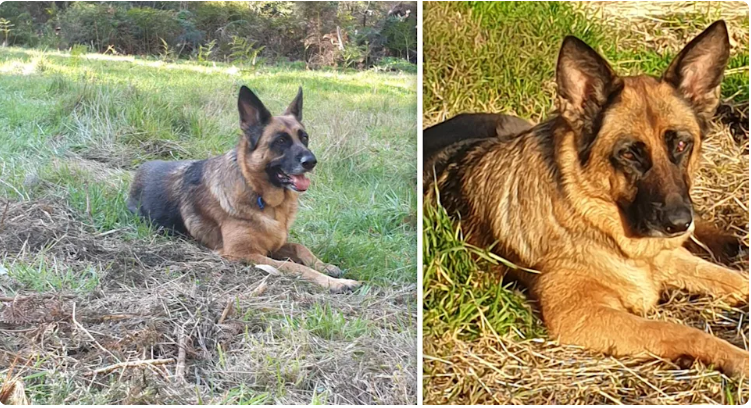Written by
Australian Dog Lover
09:11:00
-
0
Comments
You may remember the shock outbreak which occurred from the end of May 2021 to the start of July. Various businesses and suppliers quickly implemented voluntary withdrawals and recalls of potentially affected meat products.
Despite these efforts, a cluster of about 40 sick dogs quickly spread throughout the Traralgon, Bairnsdale, Mornington Peninsula and eastern suburbs of Melbourne. |
| Gippsland resident Andrew Lawrence says his dog Maggie (pictured) suffers ongoing health issues after eating contaminated meat. Source: Supplied |
All were suffering or had recently recovered from severe liver disease. Sadly, an extra 21 had unfortunately already died from the disease [1].
A link between all cases was drawn to the consumption of a specific raw pet meat product produced by the Maffra District Knackery in Gippsland. But what is it about this specific product that created such dismal consequences for dozens of Australian dogs?
What is Indospicine?
What is Indospicine?
The toxin that was found to have caused the deaths and hospitalisations of the 61 dogs is the indospicine toxin, which is found in certain species of plants of the genus Indigofera.
Indigofera plants are located in every Australian state and are often a food source for grazing animals such as cattle, horses and camels [2].
The indospicine toxin, however, is only found in certain species, predominately Indigofera spicata and Indigofera linnaei. These species differ in preferred habitats, Indigofera spicata thriving in the tropical and subtropical regions of the northern regions of Australia and Indigofera linnaei in the dry, arid central and northern regions. What they both have in common is that neither of them are found in Victoria [3]!
The indospicine toxin itself is unusual as it does not exist as part of a protein, but rather as a free amino acid (building blocks of proteins).
 |
| The structure of the indospicine amino acid |
The mammalian digestive system has a difficult time digesting indospicine and because of this it accumulates in its body tissue, especially in the pancreas and liver in camels, and in the muscle of horses [5, 6].
For the animals that graze on the indospicine containing plants, the accumulation of the toxin may lead to reduced animal performance, reduced weight gain as well as mild to severe liver disease [2].
The toxin however exhibits more dangerous effects in dogs who inadvertently consume animal meat that contains an accumulation of indospicine.
In dogs, indospicine can cause a range of effects such as lethargy, diarrhoea, lack of appetite, jaundice, and an increase in thirst and frequent urination [7]. All of these are symptomatic of liver disease and all were being experienced by a cluster of dogs in the south east of Melbourne.
So how is a toxin only found in plants located in the northern regions of Australia creating such consequences for dogs in Victoria?
So how is a toxin only found in plants located in the northern regions of Australia creating such consequences for dogs in Victoria?
When the Maffra District Knackery acquired horses to use for their raw pet meat from northern Victoria, they were unaware that those horses were originally from the Northern Territory and had therefore accumulated the toxin.
This unfortunately led to the exposure of indospicine to dozens of dogs in the Gippsland area, resulting in severe liver disease and tragically the death of some.
Pet owners are now questioning the standard of pet food regulation in Victoria to understand how something like this has been allowed to happen. In Australia, pet food is self-regulated with the industry standards provided by the Pet Food Industry Association of Australia (PFIAA), however it is voluntary for pet food suppliers to join [8].
This means anyone not part of PFIAA has any regulations they need to uphold.
PFIAA executive manager Carolyn Macgill has spoken out saying that although the indospicine toxin was well known in the industry and is on their list of banned toxins, there is currently no regulator or enforcement from a government authority, meaning the standards cannot be mandated [9].
written in 2021 by Meg Hamill, Bachelor of Biomedical Science student and Jan West, School of Life and Environmental Sciences - Deakin University
written in 2021 by Meg Hamill, Bachelor of Biomedical Science student and Jan West, School of Life and Environmental Sciences - Deakin University
(reprinted with permission).
Acknowledgements
We thank Emeritus Prof Brian Corbitt and Dr Steven Holloway (BVSc MVS PhD MACVSc Dipl. ACVIM) for valuable comments on the article.
About the authors
Megan Hamill completed her Bachelor of Biomedical Science at Deakin University at the end of 2021 and worked with the Canine Research Foundation as part of her Professional Practice Placement researching a writing a series of articles.
Assoc Prof Jan West is a lecturer in the School of Life and Environmental Sciences at Deakin University. Jan teaches human physiology to second year science students and a third year Professional Practice unit.
For further information, please visit their website oz.dogs.net.au/crf or the Facebook page.
References
1. Agriculture Victoria (Internet), Primesafe and Agriculture Victoria statement indospicine in pet meat - warning to dog owners; 2021 Hyk 30 (cited 2021 Aug 12) https://agriculture.vic.gov.au/about/media-centre/media-releases/primesafe-and-agriculture-victoria-statement-indoscpicine-in-pet-meat-warning-to-dog-owners
2. Gilbert R A, Netzel G, Chandra K, Ouwerkerk D, Fletcher M T. Degradation of the Indospicine Toxin from Indigofera spicata by a Mixed Population of Rumen Bacteria. Toxins [Internet]. 2021 May 28 [cited 2021 Aug 16];13(6):18 p. Available from doi: 10.3390/toxins13060389
3. Netzel G, Palmar D G, Masters A M, Tai S Y, Allen J G, Fletcher M T. Assessing the risk of residues of the toxin indospicine in bovine muscle and liver from north-west Australia. Toxicon [Internet]. 2019 May 14 [cited 2021 Aug 16]; 163: 48-58. Available from doi: 10.1016/j.toxicon.2019.03.007
4. Mark Marathon (Own work) [CC BY-SA 3.0 (http://creativecommons.org/lisenses/by-sa/3.0)], via Wikimedia Commons
5. Netzel G, Tan E T T, Yin M, Giles C, Yong K W L, Jassim R A, Fletcher M T. Bioaccumulation and Distribution of Indospicine and Its Foregut Metabolites in Camels Fed Indigofera spicata. Toxins [Internet]. 2019 March [cited 2021 Aug 24]; 11(3):169. Available from doi: 10.3390/toxins11030169
6. Lima E F, Riet-Correa F, Gardner D R, Barros S S, Medeiros R M T, Soares M P, Reit-Correa G. Poisoning by Indigofera lespedezioides in horses. Toxicon [Internet]. 2012 Sept 1 [cited 2021 Aug 24]; 60(3): 324-328. Available from: https://doi.org/10.1016/j.toxicon.2012.04.341
7. FitzGerald L M, Fletcher M T, Paul A E H, Mansfield C S, O’Hara A J. Hepaptotoxicosis in dogs consuming a diet of camel meat contaminated with indospicine. Aust Vet J [Internet]. 2011 Mar [cited 2021 Aug 16]; 89: 95-100. Available from doi: 10.1111/j.1751-0813.2010.00684.x
8. RSPCA Knowledgebase [Internet]. Australia: RSPCA; c2021. How is the pet food industry regulated in Australia? 2019 Aug 12 [cited 2021 Aug 24]; [about 2 screens]. Available from: https://kb.rspca.org.au/knowledge-base/how-is-the-pet-food-industry-regulated-in-australia/
9. Field E. Victorian knackery expands meat recall as toxic-plant pet deaths probe continues. ABC News. [Internet] 2021 Jul 23 [cited 2021 Aug 24]; ABC Gippsland: [about 4 screens] Available from: https://www.abc.net.au/news/2021-07-23/knackery-recalls-horsemeat/100316496
Acknowledgements
We thank Emeritus Prof Brian Corbitt and Dr Steven Holloway (BVSc MVS PhD MACVSc Dipl. ACVIM) for valuable comments on the article.
About the authors
Megan Hamill completed her Bachelor of Biomedical Science at Deakin University at the end of 2021 and worked with the Canine Research Foundation as part of her Professional Practice Placement researching a writing a series of articles.
Assoc Prof Jan West is a lecturer in the School of Life and Environmental Sciences at Deakin University. Jan teaches human physiology to second year science students and a third year Professional Practice unit.
Jan was appointed as a Trustee to the Canine Research Foundation in 2014. Her role is to coordinate the review of the grant applications received from universities around Australia and more recently has been supervising placement working for the Canine Research Foundation.
For further information, please visit their website oz.dogs.net.au/crf or the Facebook page.
References
1. Agriculture Victoria (Internet), Primesafe and Agriculture Victoria statement indospicine in pet meat - warning to dog owners; 2021 Hyk 30 (cited 2021 Aug 12) https://agriculture.vic.gov.au/about/media-centre/media-releases/primesafe-and-agriculture-victoria-statement-indoscpicine-in-pet-meat-warning-to-dog-owners
2. Gilbert R A, Netzel G, Chandra K, Ouwerkerk D, Fletcher M T. Degradation of the Indospicine Toxin from Indigofera spicata by a Mixed Population of Rumen Bacteria. Toxins [Internet]. 2021 May 28 [cited 2021 Aug 16];13(6):18 p. Available from doi: 10.3390/toxins13060389
3. Netzel G, Palmar D G, Masters A M, Tai S Y, Allen J G, Fletcher M T. Assessing the risk of residues of the toxin indospicine in bovine muscle and liver from north-west Australia. Toxicon [Internet]. 2019 May 14 [cited 2021 Aug 16]; 163: 48-58. Available from doi: 10.1016/j.toxicon.2019.03.007
4. Mark Marathon (Own work) [CC BY-SA 3.0 (http://creativecommons.org/lisenses/by-sa/3.0)], via Wikimedia Commons
5. Netzel G, Tan E T T, Yin M, Giles C, Yong K W L, Jassim R A, Fletcher M T. Bioaccumulation and Distribution of Indospicine and Its Foregut Metabolites in Camels Fed Indigofera spicata. Toxins [Internet]. 2019 March [cited 2021 Aug 24]; 11(3):169. Available from doi: 10.3390/toxins11030169
6. Lima E F, Riet-Correa F, Gardner D R, Barros S S, Medeiros R M T, Soares M P, Reit-Correa G. Poisoning by Indigofera lespedezioides in horses. Toxicon [Internet]. 2012 Sept 1 [cited 2021 Aug 24]; 60(3): 324-328. Available from: https://doi.org/10.1016/j.toxicon.2012.04.341
7. FitzGerald L M, Fletcher M T, Paul A E H, Mansfield C S, O’Hara A J. Hepaptotoxicosis in dogs consuming a diet of camel meat contaminated with indospicine. Aust Vet J [Internet]. 2011 Mar [cited 2021 Aug 16]; 89: 95-100. Available from doi: 10.1111/j.1751-0813.2010.00684.x
8. RSPCA Knowledgebase [Internet]. Australia: RSPCA; c2021. How is the pet food industry regulated in Australia? 2019 Aug 12 [cited 2021 Aug 24]; [about 2 screens]. Available from: https://kb.rspca.org.au/knowledge-base/how-is-the-pet-food-industry-regulated-in-australia/
9. Field E. Victorian knackery expands meat recall as toxic-plant pet deaths probe continues. ABC News. [Internet] 2021 Jul 23 [cited 2021 Aug 24]; ABC Gippsland: [about 4 screens] Available from: https://www.abc.net.au/news/2021-07-23/knackery-recalls-horsemeat/100316496
Related Topics:








